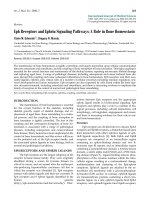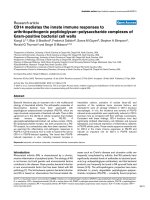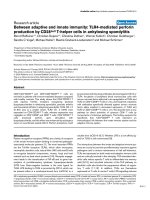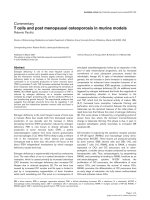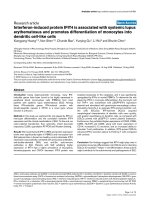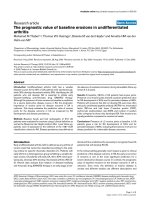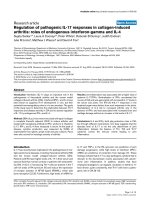Báo cáo y học: "Toll-like receptors and innate immune responses in systemic lupus" docx
Bạn đang xem bản rút gọn của tài liệu. Xem và tải ngay bản đầy đủ của tài liệu tại đây (71.75 KB, 7 trang )
Page 1 of 7
(page number not for citation purposes)
Available online />Abstract
A series of discoveries over the past several years has provided a
new paradigm for understanding autoimmunity in systemic lupus
erythematosus. The discoveries of pattern recognition receptors and
of how these receptors can be recruited into autoimmune responses
underpin this paradigm. The implications of these observations
continue to unfold with ongoing investigation into the range and
specificity of pattern recognition receptors, into how immune
complexes containing nucleic acids trigger these receptors, into how
endogenous macromolecular ‘danger signals’ stimulate innate
immune responses, and into the effect of pattern recognition
receptor activation on various cell types in initiating and perpetuating
autoimmunity. The development of clinical trials using therapeutic
agents that target components of the innate immune system
suggests that these advances may soon culminate in new
medications for treating patients with systemic lupus erythematosus.
Introduction
Pattern recognition receptors are the key to innate immune
system recognition of microbes. The strength of these
receptors in terms of their ability to respond to molecular
motifs common to pathogens may also prove to be the
weakness that results in autoimmunity, because they are
potentially less discrete than the cognate immune system in
distinguishing self from nonself. The most important pattern
recognition receptor family of receptors involved in lupus,
namely the Toll-like receptors (TLRs), can recognize a broad
range of microbial components, including DNA and RNA. In
this review we consider the implications of multiple studies
showing how these receptors play key roles in autoimmunity
in patients with systemic lupus erythematosus (SLE).
Autoantibodies
Autoantibodies to DNA, RNA, and associated proteins
represent a central puzzle in SLE pathogenesis. They are
common targets of the autoimmune response, but the
stimulus for their formation and their roles in pathogenesis
have been obscure. Although exposed protein targets, such
as β
2
-glycoprotein I and red blood cell or platelet surface
proteins, can be readily implicated in pathogenesis,
antibodies to nucleic acids also appear to contribute to
pathology. Most notably, anti-DNA antibodies are associated
with disease severity in lupus nephritis, deposit in renal
tissues, crossreact with renal antigens, and can induce
nephritis in mice. Anti-DNA antibodies can also crossreact
with the anti-N-methyl-
D-aspartate receptor and may cause
cognitive dysfunction or depression in lupus patients [1,2].
Other common targets of antinuclear antibodies include
proteins that bind to DNA and RNA [3]: histone proteins bind
and package DNA, Sm proteins bind U RNAs and direct
mRNA splicing, and Ro protein binds Y RNAs and recognizes
misfolded RNAs.
Adaptive immunity and autoantibody formation
A common theme of autoantigens in SLE is their association
in intermolecularly linked complexes associated with nucleic
acids. Autoantibodies target multiple regions of autoantigens
and have undergone affinity maturation, suggesting that their
production is aided by the adaptive immune response. The
adaptive immune response to small nuclear RNP (snRNP)
proteins has shown that B-cell epitope spreading can occur,
such that immunization of a peptide from Sm B/B’ can result
in autoantibodies to other Sm proteins [4]. Autoreactive T-cell
help is critical in epitope spreading [5], and immunization with
an immunodominant T-cell epitope, generating autoreactive
T cells, can stimulate autoreactive B cells reactive with
intermolecularly linked determinants [6]. Crossreactivity has
also been implicated in epitope spreading, particularly the
recruitment of B cells reactive with autoantigens that are not
Review
Toll-like receptors and innate immune responses in systemic
lupus erythematosus
Robert Lafyatis
1
and Ann Marshak-Rothstein
2
1
Boston University School of Medicine, Department of Medicine, Rheumatology Section, 715 Albany Street, Boston, Massachusetts 02118, USA
2
Boston University School of Medicine, Department of Microbiology, 715 Albany Street, Boston, Massachusetts 02118, USA
Correspondence: Robert Lafyatis,
Published: 29 November 2007 Arthritis Research & Therapy 2007, 9:222 (doi:10.1186/ar2321)
This article is online at />© 2007 BioMed Central Ltd
cDC = conventional dendritic cell; DC = dendritic cell; FcγR = Fcγ receptor; HMGB = high mobility group box; IFN = interferon; IL = interleukin;
MFG-E = milk fat globule-epidermal growth factor; pDC = plasmacytoid dendritic cell; RAGE = receptor for advanced glycation end-products; SLE =
systemic lupus erythematosus; snRNP = small nuclear RNP; snoRNP = small nucleolar RNP; Th1 = T-helper-1; TLR = Toll-like receptor; TNF =
tumor necrosis factor; Yaa = Y-linked autoimmune accelerator.
Page 2 of 7
(page number not for citation purposes)
Arthritis Research & Therapy Vol 9 No 6 Lafyatis and Marshak-Rothstein
molecularly linked to the immunizing peptide, such as Ro and
La [7].
Unlike protein antigens, nucleic acids cannot be processed
to components recognized by T cells. However, as for protein
autoantigen targets, antibodies to nucleic acids (anti-DNA
antibodies) exhibit somatic mutations, suggesting T-cell help
in their generation. It is most likely that T-cell help is directed
to histones or other DNA-binding proteins in DNA-containing
nucleosomes [8]. Thus, adaptive immune responses can
target both DNA and RNA-containing molecular complexes.
Importantly, complexes taken up by antigen-presenting cells
can stimulate autoreactive T cells to help B cells reactive with
either proteins or nucleic acids within the complex.
The innate immune system in autoantibody production
In virtually all studies of induced murine autoimmunity,
adjuvant is required to initiate the immune response to auto-
antigens or derived peptides. In many if not all cases, these
adjuvants are innate immune stimuli. Furthermore, although
adaptive immune responses can explain such phenomena as
epitope spreading and the observed presence of auto-
antibodies against intermoleculary linked protein complexes,
innate immune mechanisms also contribute to such events. In
addition, innate immune system activation provides the most
ready explanation for highly increased IFN-regulated gene
expression observed in leukocytes from SLE patients. These
and other observations discussed below indicate that innate
immune recognition plays a key role in the initial development
and amplification of the immune response to both nucleic
acid and nucleic acid binding autoantigens. Indeed, in the
enthusiasm with which the immune system eliminates
microbes, these autoantigens may represent an Achilles heel
of overactivity; the critical stimulants of the innate immune
system in SLE patients may be nucleic acid/protein complexes,
which can serve as both immunogens and adjuvants.
Innate immune sensors
The nucleic acid binding TLRs appear to play pivotal roles in
SLE. TLR7 and TLR8 bind to single-stranded RNA, TLR3 to
double-stranded RNA, and TLR 9 to DNA. These receptors
are intracellular and are engaged by their ligands in a cyto-
plasmic compartment of the endoplasmic reticulum-endo-
some-lysosome lineage [9]. Engagement of these receptors
provides a mechanism for host responses to nucleic acids,
and ultimately for the production of autoantibodies to nucleic
acids and proteins bound to nucleic acids. Disruption of this
signaling may be a major mechanism of action of antimalarial
agents, which inhibit nucleic acid TLR signaling in vitro by
blocking endosomal maturation [10,11].
DNA and Toll-like receptor 9 activation
Several mechanisms serve to promote the specificity of
responses to nucleic acids, so that innate immune cells sense
and respond to viral and bacterial but not host nucleic acid.
This is best understood for DNA. Hypomethylated CpG-
containing DNA selectively activates TLR9. CpG motifs in
mammalian DNA are relatively rare and generally methylated,
so that mammalian DNA is a weak TLR9 agonist [12]. In
addition, mammalian DNA contains sequences that suppress
TLR9 activation [13]. Further suggesting the importance of
DNA methylation and TLR9 in autoimmunity, two common
medications frequently associated with drug-induced SLE,
namely hydralazine and procainamide, inhibit DNA
methylation [14]. These observations help to explain why
mammalian DNA does not normally activate the immune
system. In lupus sera, however, seminal observations indicate
that circulating immune complexes (ICs) containing DNA
stimulate dendritic cell (DC) production of type I IFNs [15].
How DNA becomes an immune adjuvant therefore remains a
central question in lupus pathogenesis.
RNA and Toll-like receptor 7/8 activation
Parallel studies have investigated the role of RNA-containing
ICs in innate immune system activation. Lupus sera incubated
with apoptotic cell debris exhibit IFN-inducing activity
associated with anti-RNP reactivity rather than anti-DNA
activity [16]. TLR7 is activated by single-stranded RNA
containing U and G rich motifs [17,18]. Thus, highly U/G-rich
U and Y RNAs bound respectively to snRNP and Ro/La auto-
antigens both stimulate TLR7 and/or TLR8 [19]. Methylated
or modified nucleosides found frequently in mammalian RNAs
markedly decrease the activity on TLR7 activation [20],
suggesting that, as for DNA, mammalian RNA modifications
permit a degree of selectivity for responses by innate immune
receptors to pathogens. Why and how, then, do these
mammalian nucleic acids become endogenous TLR activators?
Endogenous ligands of Toll-like receptor activation
Recent studies have shown that autoantibody-nucleic acid
complexes from SLE patents are able to act as endogenous
immune adjuvants and shed light on the mechanisms of IC
internalization. Early work showed that sera from lupus
patients contain a soluble factor that stimulates leukocytes to
secrete IFNs [15]. These studies suggested that the
circulating factor might include DNA in ICs and fit well with
data showing that CpG DNA oligonucleotides can enter cells
and stimulate TLR9. Other studies showed that single-
stranded RNA stimulates TLR7 and TLR8 [18], suggesting
that RNA-containing ICs might stimulate these TLRs.
More recent work has clarified how ICs containing nucleic acid
can enter cells, stimulate TLRs, and thereby provoke an immune
response. Before DNA can activate TLR9 or RNA activate TLR7
and TLR8, they must enter the proper intracellular compartment.
The B-cell receptor was shown to mediate TLR9 activation
using B cells from rheumatoid factor transgenic mice (AM14
cells) [21]. These studies were extended to show that
haptenated DNA could bind to and stimulate TLR9 in B cell
expressing hapten-specific receptors [22], further clarifying that
autoantigens bound by the B-cell receptor can be delivered to
the proper intracellular compartment to trigger TLR9 activation.
Page 3 of 7
(page number not for citation purposes)
These B cells were found to proliferate in response to
hypomethylated DNA/anti-DNA ICs, but only certain DNA
sequences promoted robust responses [22].
Subsequent work showed that Fc receptors on DCs
(plasmacytoid dendritic cells [pDCs]) can bind to the
immunoglobulin Fc component of nucleic acid containing ICs,
internalize the ICs, and deliver the nucleic acid component to
intracellular TLRs. The importance of Fc receptors on DCs was
first suggested in the IFN production by human pDCs induced
by SLE sera in the presence of apoptotic cells. Blocking the
high-affinity Fcγ receptor (FcγR)II/CD32 inhibited IFN
production [23]. FcγRII/CD32 on pDCs was subsequently
shown to be required for IFN production and to co-localize with
TLR9 after exposure to DNA-containing ICs [24]. In murine
myeloid DCs, FcγRIII was required for DNA IC activation [25].
Although these studies showed that DNA/anti-DNA complexes
can stimulate TLR9, similar mechanisms indicate that RNA-
binding proteins such as snRNPs can participate in a similar
mechanism, because incubation with snRNP ICs stimulates
TLR7-dependent IFN production by pDCs [19,26].
Effector mechanisms of innate immune
stimulation in systemic lupus erythematosus
Different immune cell types express different subsets of
TLRs. In addition, the effects of TLR stimulation depend not
only on the specific TLR activated but also on the cell type
expressing the TLR. In SLE the roles of TLR activation in B
cells and DCs are the most evident; the effects of TLR
activation in these cell types (autoantibody and IFN
production) are clearly implicated in SLE pathogenesis.
Toll-like receptor activation of B cells
Normal individuals have circulating B cells that contain a
substantial percentage of autoreactive specificities [27],
providing a large pool of autoreactive B cells that might be
activated through protein/nucleic acid ICs. Oligonucleotide
TLR9 agonists, and TLR7 agonists after exposure to IFN-α
can activate both memory and naïve B cells, resulting in class
switching and maturation into immunoglobulin-secreting
plasmablasts [28-30]. TLR-stimulated B-cell activation may
also contribute to SLE pathogenesis through mechanisms
that do not directly involve autoantibody production, such as
antigen presentation or cytokine production [31].
Toll-like receptor activation of dendritic cells
DCs include several cell types. Traditional or myeloid DCs
can be found in the circulation, and an apparently similar cell
type can be derived from monocytes by treatment in vitro.
These cells reside in peripheral tissues where their primary
role appears to be antigen processing and presentation. A
second more recently recognized DC is the pDC. These
latter cells appear particularly important in the innate immune
dysfunction in SLE. Although they represent a small
population of circulating mononuclear cells, these cells are
the dominant source of type I IFNs [32,33]. They harbor both
TLR7 and TLR9 receptors and are exquisitely sensitive to
RNA and DNA stimulation.
Conventional DCs (cDCs) express and respond to TLR
stimuli and might promote autoimmunity by affecting T-cell
help. TLR7/8 in combination with TLR3/4 activation or IL-4
stimulate IL-12 secretion by cDCs, promoting T-helper-1
(Th1) T-cell differentiation [34]. TLR-elicited functions can
also be modified by co-engagement of non-TLR receptors.
For example, stimulation with experimental ligands, such as
CpG oligonucleotides, induces murine cDCs to secrete IL-12
as well as tumor necrosis factor (TNF)-α, whereas chromatin
ICs promote only secretion of TNF-α [25]. These latter results
emphasize the potentially important differences in cellular
responses to synthetic oligonucleotides compared with
naturally occurring TLR ligands. Monocytes can also be
induced to secrete IL-12 through a combination of TLR4 and
TLR8 stimulation [34]. Thus, TLR activation by nucleic acid
containing ICs can act alone or as co-stimulants for IL-12
secretion and Th1 cell skewing. Although the effects of such
skewing on autoimmunity are not entirely clear, IFN-γ (a major
product of Th1 cells) contributes to nephritis in murine lupus
models [35,36].
Type I interferons in systemic lupus erythematosus
The importance of type I IFNs in lupus pathogenesis has
emerged from several observations, led by microarray
analyses of gene expression of leukocytes from lupus patients
[37,38]. Leukocytes from lupus patients exhibit highly
increased expression of a wide variety of genes that are
known to be upregulated by IFNs. This effect appears to be
mediated by IFN-α subtypes secreted prominently by pDCs. A
prominent role for type I IFNs in lupus was further suggested
by the occasional development of autoimmunity and lupus in
patients treated with IFN for hepatitis C infection.
IFN production is normally a feature of the immune response
to microbial infections and has multiple effects on the immune
system. Type I IFNs stimulate monocyte maturation into DCs,
plasma cell maturation and immunoglobulin class switching,
cytotoxic T and natural killer cell activity, and chemokine
secretion. Type I IFNs also highly upregulate TLR7 expression,
providing a strong positive feedback loop that might
perpetuate autoimmunity to RNA-associated autoantigens.
Although type I IFNs can stimulate these effects, which would
be expected to promote autoimmunity, the role of type I IFNs
in human disease remains incompletely understood, given the
unexpected disease found in certain autoimmune prone, IFN
receptor deleted mice [39]. In addition, the relative
importance of these various effects in lupus pathogenesis is
unknown and other inflammatory cytokines stimulated by TLR
activation, such as TNF-α and IL-6, may also play key roles.
Cellular debris and immune clearance
A likely source of intracellular antigens for immune stimulation
in SLE became clear with the appreciation that ongoing cell
Available online />death in the body provides a constant burden of cellular
debris that must be cleared from the circulation [40]. Cells
can die in different ways, including apoptosis, necrosis, and
autophagy. Of these mechanisms, apoptosis has been most
clearly implicated in human lupus and murine lupus models.
Mice injected with apoptoic cells in the absence of adjuvant
produce autoantibodies, including antibodies to DNA [41],
whereas mammalian DNA alone has no activity [42]. These
observations suggest that cell death provides a change in
chromatin structure or composition that promotes an immune
response, or that apopototic DNA is delivered to a different
intracellular compartment than ‘free’ DNA. The molecular
mechanisms that lead to this change remain unclear even as
the process of clearing apoptotic debris has become better
understood.
Cell death and autoimmunity
Apoptosis is associated with the redistribution of phospha-
tidylserine, normally an internal membrane lipid, to the cell
surface. Incompletely identified receptors for phosphatidyl-
serine and several other ligand-receptor pairs help phago-
cytes to recognize apoptotic cells and remove them from the
circulation [40,43] through sequential tethering and engulf-
ment. Particularly notable with regard to autoimmunity are
complement, secretory IgM, milk fat globule-epidermal growth
factor (MFG-E)8 and tyro 3 kinases, because alterations in
these proteins are associated with autoimmunity. Apopotic
cells express binding sites for C1q and C3b/bi that can bind
to the CR3 and CR4 complement receptors. C1q deletion
leads to glomerulonephritis and is associated with increased
numbers of apoptotic cells [44]. C3b/bi associates with
phosphatidyserine on apoptotic cells and binds to C3 and
C4 complement receptors on macrophages, facilitating
apoptotic cell clearance [45]. These observations are
particularly intriguing in light of the known complement
deficiencies associated with human lupus. Natural IgM
autoantibodies facilitate complement binding [46]. MFG-E8
also associates with phosphatidylserine, and its deletion
leads to decreased apoptotic cell clearance in lymphoid
organs, autoantibodies, and glomerulonephritis [47].
Apoptotic cells are thought to result in ‘silent death’, in the
sense that an important feature of this regulated process is to
allow effective disposal without immune activation. Anti-
inflammatory effects of apoptotic cells are mediated through
phagocyte production of transforming growth factor-β and
IL-10. In addition, Gas-6 on apoptotic cells binding to
receptor kinases of Tyro 3 family (mer, tyro and axl) down-
regulate inflammatory cytokines, IL-12 and TNFα during
ingestion, and deletion of these three kinases together leads
to autoimmunity [48]. Although thought to be largely silent,
the development of autoimmunity in mice with defects in
apoptotic cell clearance suggests that overwhelming of these
systems can stimulate an immune response. Whether these
mice exhibit evidence of TLR-mediated activation remains to
be determined, but the role of TLR activation has been
investigated in other models of autoimmunity (discussed
below).
The form of apoptotic versus necrotic debris may also be
important for TLR recognition of nucleic acids. Proteolytic
cleavage of proteins may reveal cryptic antigens or create
neoepitopes [49]. Different stages of apoptosis may
differentially alter autoantigens, so that early compared with
late apoptosis results in different autoantigen fragments
[43,50]. In addition, necrotic cells induce different signals
from those of apoptotic cells; specifically, they activate EKR1,
may leak nucleic acid containing immunostimulatory
complexes more readily, and induce inflammatory signals in
part by releasing high mobility group box (HMGB) proteins
(discussed further below) [51,52]. Thus, the type of cell
death (apoptotic versus necrotic) and the stage or duration of
apoptosis when the dying cell is cleared might affect not only
protein autoantigens but also the interactions between
proteins and complexed nucleic acids.
High mobility group box protein release from necrotic
cells and stimulation of Toll-like receptor 9 by DNA
HMGB proteins provide a new paradigm for how cell death
may be linked to innate immune responses. HMGB1 is a
transcriptional regulator that binds more avidly to DNA from
apoptotic than to DNA from necrotic cells. When released
from necrotic cells it stimulates inflammatory cytokines
through the receptor for advanced glycation end-products
(RAGE) [52,53]. Cells that are not cleared promptly during
apoptosis may undergo secondary necrosis and release
cellular components that would normally not gain access to
the extracellular milieu. Such cells may release DNA that was
tightly bound by HMGB1 [52]. More recent studies suggest
that HMGB1 binding to DNA enhances the interaction of the
HMGB1/DNA complex to both TLR9 and RAGE, the
HMGB1 receptor [54,55]. HMGB1 also augments chromatin
IC stimulation of B-cell proliferation. The release of such
complexes may explain how mammalian DNA is able to
stimulate TLR9. This and other unidentified mechanisms
might be responsible for rendering mammalian DNA and RNA
from apoptotic and necrotic cells stimulatory to nucleic acid
sensing TLRs.
Toll-like receptors in murine models of
autoimmunity
The importance of TLR activation has been studied in several
animal models of lupus. In the MRL/lpr mouse, deletion of the
fas gene leads spontaneously to the development of
autoantibodies to DNA and snRNPs (Sm), and associated
nephritis and dermatitis. Deletion of the TLR9 gene largely
blocked the development of anti-DNA antibodies in MRL/lpr
mice, but it exacerbated clinical disease [56]. The role played
by TLR9 has also been studied in a major histocompatibility
complex class II disparate graft-versus-host disease model of
SLE, in which TLR9 deficiency once again resulted in lower
titers of anti-DNA antibodies but no amelioration of clinical
Arthritis Research & Therapy Vol 9 No 6 Lafyatis and Marshak-Rothstein
Page 4 of 7
(page number not for citation purposes)
nephritis [56]. In yet a third model of SLE that develops in
mice expressing mutant phospholipase C2, TLR9 deletion
results in increased antinucleolar antibodies, probably directed
against RNA-containing small nucleolar RNP (snoRNP), and
appears actually to increase the severity of nephritis [57].
Although not conclusive and at odds with the generally
accepted role of anti-DNA antibodies in lupus pathogenesis,
these studies strongly support the roles of TLRs in the
development of autoantibodies, but they suggest that
autoimmunity to DNA mediated by TLR9 is not pathogenic but
in some cases may actually ameliorate disease. In contrast to
these models, TLR9 agonist, CpG oligonucleotide treatment
of MRL(lpr/lpr) mice triggered both anti-DNA antibodies and
nephritis, suggesting that the effect of TLR9 may depend on
specific features of the particular murine model or on co-
activation of other TLRs, such as TLR7 [58].
Studies of TLR7 in murine lupus models emphasize the
importance of this TLR in stimulating autoantibodies to
RNA/protein complexes and in promoting clinical auto-
immune disease. Deletion of TLR7 in MRL/lpr mice blocks the
development of anti-snRNP antibodies (Sm), and in contrast
to TLR9 deletion it ameliorates clinical disease [59]. The
importance of TLR7 in developing autoimmunity to RNA/
protein complexes is further supported by the observation
that the Y-linked autoimmune accelerator (Yaa) includes a
duplication of TLR7 [60]. Originally identified in BXSB mice,
Yaa accelerates autoimmunity in this and other murine
models of SLE. In B6 FcγRIIb-deleted mice (another murine
model of lupus), Yaa leads to markedly accelerated auto-
immunity, nephritis, and, notably, a shift from anti-DNA toward
anti-nucleolar antibodies. Yaa also markedly accelerates
autoimmunity in B6 mice harboring the Sle1, autoimmune
haplotype [61]. Together, these data strongly implicate TLR7
in the production of autoantibodies to RNA/protein molecular
complexes, such as snRNPs and snoRNPs. These studies
also suggest that these autoantibodies and/or other effects of
TLR7 activation contribute to SLE disease manifestations,
including nephritis.
Viral infections and innate immunity
A relationship between TLR activation, IFN, and autoimmunity
has also been shown in infectious illnesses. Indeed, lupus
exhibits remarkable similarities to and might be triggered by
infectious TLR activation. Type I IFN production is a key step
in fighting viral infections, and viral defenses develop
elaborate methods for inhibiting IFN or its signaling [62]. For
example, in hepatitis C viral proteins NS2 and NS3/4A inhibit
IFN production, possibly contributing to the chronic survival
of the hepatitis C virus in the host [63]. Notably, although
such patients’ infections often respond to IFN, these IFN-
treated patients occasionally develop antinuclear antibodies
and SLE. In murine models autoimmunity can be induced by
TLR3 activation within the context of a T-cell viral or
autoantigen stimulus [64,65]. Thus, TLRs can augment
immune responses to infectious organisms and such activity
might lead to autoimmunity. Although infectious diseases,
such as Epstein-Barr viral infections have been suggested to
play roles in SLE [66], an infectious trigger has not yet been
proven. These studies also highlight the potential complemen-
tary roles played by the adaptive and innate immune systems
in both responding to infections and inducing autoimmunity.
Theapeutic implications
Toll-like receptors as therapeutic targets
As data linking TLR activation and IFN-α secretion accumu-
late, methods for manipulating these receptors has advanced
at an equal or even faster pace. The excitement surrounding
activating TLRs for treatment of infectious and oncologic
diseases, and in particular in vaccine development, assures
an enduring interest in TLR therapeutics that extends to
autoimmunity [67]. For autoimmune disease, of course, the
goal is different of course. For SLE, anticipated therapeutics
will inhibit TLR activation. Much has been learned about both
the activation and inhibition of the nucleic acid TLRs through
relatively straightforward experiments by modifying the
sequence and structural motifs in synthetic oligonucleotides.
Inhibitory oligonucleotides have been described for both
TLR7 and TLR9 [68,69].
The differences in effector cell expression of TLRs should
provide some specificity for the cell type(s) targeted as
selective antagonists of TLR7, TLR8, and TLR9 are
developed as human therapeutic agents. For example, TLR7
and TLR9 are found on B cells and pDCs but not on
monocytes or cDCs, which instead express TLR8 (as well as
other TLRs). In addition, different TLR therapies might be
designed based on autoantibody profiles and/or disease
manifestations. For example, patients with anti-DNA
antibodies and lupus nephritis might respond to TLR9
inhibition, whereas patients with anti-snRNP or Ro antibodies
might respond better to TLR7/8 inhibition. However, murine
studies remain unclear at this point regarding the precise role
of TLR9 in pathogenesis. Data showing enhanced disease in
TLR9-deleted mice may reflect a permissive effect for TLR7-
activated pathways. Thus, we expect and anticipate that
models of lupus in mice deleted of both TLR7 and TLR9 with
provide additional insight into the potential therapeutic role of
TLR9 inhibition in lupus.
Targeting type I interferons in systemic lupus
erythematosus
The parallel discoveries of the role of TLRs in stimulating type
I IFNs, of pDCs as the primary source of this cytokine, and of
the IFN-signature in lupus patients by microarray analyses
[37,38] have identified the type I IFN as another promising
therapeutic target, which is under active investigation for
treatment of SLE. Because the IFN-α family includes 13
isotypes, its inhibition may prove challenging, but several
pharmaceutical companies are developing multi-isotype
IFN-α blocking antibodies for therapy in humans, as well as
antibodies to the unique type I IFN receptor [70,71].
Available online />Page 5 of 7
(page number not for citation purposes)
Conclusion
Nucleic acid/protein ICs from lupus patients act as immune
adjuvants in vitro and play key roles in murine models of
lupus. The activity of these ICs appears largely to be
mediated by intracellular, nucleic acid binding TLRs, stimu-
lating B-cell maturation and pDC secretion of IFN-α. These
findings provide a new framework for understanding lupus
pathogenesis and suggest new therapeutic targets, some of
which might be targeted by already identified and readily
synthesized oligonucleotides. Ongoing investigations should
provide further insights into the source of nucleic acid/protein
molecular complexes, how these complexes enter the cell,
and why these complexes become immune stimulants in
lupus but not normal individuals.
Competing interests
AM-R has applied for a US patent application (10/487,885)
entitled, Method and Composition for Treating Immune
Complex Associated Disorders. Corresponding foreign
applications have been licensed and provide royalty income.
References
1. DeGiorgio LA, Konstantinov KN, Lee SC, Hardin JA, Volpe BT,
Diamond B: A subset of lupus anti-DNA antibodies cross-
reacts with the NR2 glutamate receptor in systemic lupus ery-
thematosus. Nat Med 2001, 7:1189-1193.
2. Lapteva L, Nowak M, Yarboro CH, Takada K, Roebuck-Spencer T,
Weickert T, Bleiberg J, Rosenstein D, Pao M, Patronas N, et al.:
Anti-N-methyl-D-aspartate receptor antibodies, cognitive dys-
function, and depression in systemic lupus erythematosus.
Arthritis Rheum 2006, 54:2505-2514.
3. Stein AJ, Fuchs G, Fu C, Wolin SL, Reinisch KM: Structural
insights into RNA quality control: the Ro autoantigen binds
misfolded RNAs via its central cavity. Cell 2005, 121:529-539.
4. James JA, Gross T, Scofield RH, Harley JB: Immunoglobulin
epitope spreading and autoimmune disease after peptide
immunization: Sm B/B’-derived PPPGMRPP and PPPGIRGP
induce spliceosome autoimmunity. J Exp Med 1995, 181:453-
461.
5. Fatenejad S, Mamula MJ, Craft J: Role of intermolecular/
intrastructural B- and T-cell determinants in the diversification
of autoantibodies to ribonucleoprotein particles. Proc Natl
Acad Sci USA 1993, 90:12010-12014.
6. Deshmukh US, Bagavant H, Sim D, Pidiyar V, Fu SM: A SmD
peptide induces better antibody responses to other proteins
within the small nuclear ribonucleoprotein complex than to
SmD protein via intermolecular epitope spreading. J Immunol
2007, 178:2565-2571.
7. Deshmukh US, Bagavant H, Lewis J, Gaskin F, Fu SM: Epitope
spreading within lupus-associated ribonucleoprotein anti-
gens. Clin Immunol 2005, 117:112-120.
8. Lu L, Kaliyaperumal A, Boumpas DT, Datta SK: Major peptide
autoepitopes for nucleosome-specific T cells of human lupus.
J Clin Invest 1999, 104:345-355.
9. Ahmad-Nejad P, Hacker H, Rutz M, Bauer S, Vabulas RM,
Wagner H: Bacterial CpG-DNA and lipopolysaccharides acti-
vate Toll-like receptors at distinct cellular compartments. Eur
J Immunol 2002, 32:1958-1968.
10. Lafyatis R, York M, Marshak-Rothstein A: Antimalarial agents:
closing the gate on Toll-like receptors? Arthritis Rheum 2006,
54:3068-3070.
11. Parroche P, Lauw FN, Goutagny N, Latz E, Monks BG, Visintin A,
Halmen KA, Lamphier M, Olivier M, Bartholomeu DC, et al.:
Malaria hemozoin is immunologically inert but radically
enhances innate responses by presenting malaria DNA to
Toll-like receptor 9. Proc Natl Acad Sci USA 2007, 104:1919-
1924.
12. Stacey KJ, Young GR, Clark F, Sester DP, Roberts TL, Naik S,
Sweet MJ, Hume DA: The molecular basis for the lack of
immunostimulatory activity of vertebrate DNA. J Immunol
2003, 170:3614-3620.
13. Gursel I, Gursel M, Yamada H, Ishii KJ, Takeshita F, Klinman DM:
Repetitive elements in mammalian telomeres suppress bac-
terial DNA-induced immune activation. J Immunol 2003, 171:
1393-1400.
14. Cornacchia E, Golbus J, Maybaum J, Strahler J, Hanash S,
Richardson B:
Hydralazine and procainamide inhibit T cell
DNA methylation and induce autoreactivity. J Immunol 1988,
140:2197-2200.
15. Vallin H, Blomberg S, Alm GV, Cederblad B, Ronnblom L:
Patients with systemic lupus erythematosus (SLE) have a cir-
culating inducer of interferon-alpha (IFN-alpha) production
acting on leucocytes resembling immature dendritic cells.
Clin Exp Immunol 1999, 115:196-202.
16. Bave U, Alm GV, Ronnblom L: The combination of apoptotic
U937 cells and lupus IgG is a potent IFN-alpha inducer. J
Immunol 2000, 165:3519-3526.
17. Diebold SS, Kaisho T, Hemmi H, Akira S, Reis e Sousa C: Innate
antiviral responses by means of TLR7-mediated recognition
of single-stranded RNA. Science 2004, 303:1529-1531.
18. Heil F, Hemmi H, Hochrein H, Ampenberger F, Kirschning C, Akira
S, Lipford G, Wagner H, Bauer S: Species-specific recognition
of single-stranded RNA via toll-like receptor 7 and 8. Science
2004, 303:1526-1529.
19. Vollmer J, Tluk S, Schmitz C, Hamm S, Jurk M, Forsbach A, Akira
S, Kelly KM, Reeves WH, Bauer S, Krieg AM: Immune stimula-
tion mediated by autoantigen binding sites within small
nuclear RNAs involves Toll-like receptors 7 and 8. J Exp Med
2005, 202:1575-1585.
20. Kariko K, Buckstein M, Ni H, Weissman D: Suppression of RNA
recognition by Toll-like receptors: the impact of nucleoside
modification and the evolutionary origin of RNA. Immunity
2005, 23:165-175.
21. Leadbetter EA, Rifkin IR, Hohlbaum AM, Beaudette BC, Shlom-
chik MJ, Marshak-Rothstein A: Chromatin-IgG complexes acti-
vate B cells by dual engagement of IgM and Toll-like
receptors. Nature 2002, 416:603-607.
22. Viglianti GA, Lau CM, Hanley TM, Miko BA, Shlomchik MJ,
Marshak-Rothstein A: Activation of autoreactive B cells by CpG
dsDNA. Immunity 2003, 19:837-847.
23. Bave U, Magnusson M, Eloranta ML, Perers A, Alm GV, Ronnblom
L: Fc gamma RIIa is expressed on natural IFN-alpha-produc-
ing cells (plasmacytoid dendritic cells) and is required for the
IFN-alpha production induced by apoptotic cells combined
with lupus IgG. J Immunol 2003, 171:3296-3302.
24. Means TK, Latz E, Hayashi F, Murali MR, Golenbock DT, Luster
AD: Human lupus autoantibody-DNA complexes activate DCs
through cooperation of CD32 and TLR9. J Clin Invest 2005,
115:407-417.
25. Boule MW, Broughton C, Mackay F, Akira S, Marshak-Rothstein
A, Rifkin IR: Toll-like receptor 9-dependent and -independent
dendritic cell activation by chromatin-immunoglobulin G com-
plexes. J Exp Med 2004, 199:1631-1640.
26. Savarese E, Chae OW, Trowitzsch S, Weber G, Kastner B, Akira
S, Wagner H, Schmid RM, Bauer S, Krug A: U1 small nuclear
ribonucleoprotein immune complexes induce type I interferon
in plasmacytoid dendritic cells through TLR7. Blood 2006,
107:3229-3234.
27. Wardemann H, Yurasov S, Schaefer A, Young JW, Meffre E,
Nussenzweig MC: Predominant autoantibody production by
early human B cell precursors. Science 2003, 301:1374-1377.
28. Bekeredjian-Ding IB, Wagner M, Hornung V, Giese T, Schnurr M,
Endres S, Hartmann G: Plasmacytoid dendritic cells control
TLR7 sensitivity of naive B cells via type I IFN. J Immunol 2005,
174:4043-4050.
29. Berland R, Fernandez L, Kari E, Han JH, Lomakin I, Akira S, Wortis
HH, Kearney JF, Ucci AA, Imanishi-Kari T: Toll-like receptor 7-
dependent loss of B cell tolerance in pathogenic autoantibody
knockin mice. Immunity 2006, 25:429-440.
30. He B, Qiao X, Cerutti A: CpG DNA induces IgG class switch
DNA recombination by activating human B cells through an
innate pathway that requires TLR9 and cooperates with IL-10.
J Immunol 2004, 173:4479-4491.
31. Chan OT, Madaio MP, Shlomchik MJ: The central and multiple
roles of B cells in lupus pathogenesis. Immunol Rev 1999,
169:107-121.
Arthritis Research & Therapy Vol 9 No 6 Lafyatis and Marshak-Rothstein
Page 6 of 7
(page number not for citation purposes)
32. Liu YJ: IPC: professional type 1 interferon-producing cells and
plasmacytoid dendritic cell precursors. Annu Rev Immunol
2005, 23:275-306.
33. Ronnblom L, Alm GV: A pivotal role for the natural interferon
alpha-producing cells (plasmacytoid dendritic cells) in the
pathogenesis of lupus. J Exp Med 2001, 194:F59-F63.
34. Bekeredjian-Ding I, Roth SI, Gilles S, Giese T, Ablasser A,
Hornung V, Endres S, Hartmann G: T cell-independent, TLR-
induced IL-12p70 production in primary human monocytes. J
Immunol 2006, 176:7438-7446.
35. Peng SL, Moslehi J, Craft J: Roles of interferon-gamma and
interleukin-4 in murine lupus. J Clin Invest 1997, 99:1936-
1946.
36. Ozmen L, Roman D, Fountoulakis M, Schmid G, Ryffel B, Garotta
G: Experimental therapy of systemic lupus erythematosus:
the treatment of NZB/W mice with mouse soluble interferon-
gamma receptor inhibits the onset of glomerulonephritis. Eur
J Immunol 1995, 25:6-12.
37. Baechler EC, Batliwalla FM, Karypis G, Gaffney PM, Ortmann
WA, Espe KJ, Shark KB, Grande WJ, Hughes KM, Kapur V, et al.:
Interferon-inducible gene expression signature in peripheral
blood cells of patients with severe lupus. Proc Natl Acad Sci
USA 2003, 100:2610-2615.
38. Crow MK, Kirou KA, Wohlgemuth J: Microarray analysis of inter-
feron-regulated genes in SLE. Autoimmunity 2003, 36:481-
490.
39. Hron JD, Peng SL: Type I IFN protects against murine lupus. J
Immunol 2004, 173:2134-2142.
40. Lauber K, Blumenthal SG, Waibel M, Wesselborg S: Clearance
of apoptotic cells: getting rid of the corpses. Mol Cell 2004,
14:277-287.
41. Mevorach D, Zhou JL, Song X, Elkon KB: Systemic exposure to
irradiated apoptotic cells induces autoantibody production. J
Exp Med 1998, 188:387-392.
42. Gilkeson GS, Grudier JP, Karounos DG, Pisetsky DS: Induction
of anti-double stranded DNA antibodies in normal mice by
immunization with bacterial DNA. J Immunol 1989, 142:1482-
1486.
43. Wu Y, Tibrewal N, Birge RB: Phosphatidylserine recognition by
phagocytes: a view to a kill. Trends Cell Biol 2006, 16:189-197.
44. Botto M, Dell’Agnola C, Bygrave AE, Thompson EM, Cook HT,
Petry F, Loos M, Pandolfi PP, Walport MJ: Homozygous C1q
deficiency causes glomerulonephritis associated with multi-
ple apoptotic bodies. Nat Genet 1998, 19:56-59.
45. Mevorach D, Mascarenhas JO, Gershov D, Elkon KB: Comple-
ment-dependent clearance of apoptotic cells by human
macrophages. J Exp Med 1998, 188:2313-2320.
46. Peng Y, Kowalewski R, Kim S, Elkon KB: The role of IgM anti-
bodies in the recognition and clearance of apoptotic cells. Mol
Immunol 2005, 42:781-787.
47. Hanayama R, Tanaka M, Miyasaka K, Aozasa K, Koike M,
Uchiyama Y, Nagata S: Autoimmune disease and impaired
uptake of apoptotic cells in MFG-E8-deficient mice. Science
2004, 304:1147-1150.
48. Lu Q, Lemke G: Homeostatic regulation of the immune system
by receptor tyrosine kinases of the Tyro 3 family. Science
2001, 293:306-311.
49. Hall JC, Casciola-Rosen L, Rosen A: Altered structure of
autoantigens during apoptosis. Rheum Dis Clin North Am
2004, 30:455-471, vii.
50. Wu X, Molinaro C, Johnson N, Casiano CA: Secondary necrosis
is a source of proteolytically modified forms of specific intra-
cellular autoantigens: implications for systemic autoimmunity.
Arthritis Rheum 2001, 44:2642-2652.
51. Patel VA, Longacre A, Hsiao K, Fan H, Meng F, Mitchell JE, Rauch
J, Ucker DS, Levine JS: Apoptotic cells, at all stages of the
death process, trigger characteristic signaling events that are
divergent from and dominant over those triggered by necrotic
cells: Implications for the delayed clearance model of autoim-
munity. J Biol Chem 2006, 281:4663-4670.
52. Scaffidi P, Misteli T, Bianchi ME: Release of chromatin protein
HMGB1 by necrotic cells triggers inflammation. Nature 2002,
418:191-195.
53. DeMarco RA, Fink MP, Lotze MT: Monocytes promote natural
killer cell interferon gamma production in response to the
endogenous danger signal HMGB1. Mol Immunol 2005, 42:
433-444.
54. Ivanov S, Dragoi AM, Wang X, Dallacosta C, Louten J, Musco G,
Sitia G, Yap GS, Wan Y, Biron CA, et al.: A novel role for
HMGB1 in TLR9-mediated inflammatory responses to CpG-
DNA. Blood 2007, 110:1970-1981.
55. Tian J, Avalos AM, Mao SY, Chen B, Senthil K, Wu H, Parroche P,
Drabic S, Golenbock D, Sirois C, et al.: Toll-like receptor 9-
dependent activation by DNA-containing immune complexes
is mediated by HMGB1 and RAGE. Nat Immunol 2007, 8:487-
496.
56. Ma Z, Chen F, Madaio MP, Cohen PL, Eisenberg RA: Modulation
of autoimmunity by TLR9 in the chronic graft-vs-host model of
systemic lupus erythematosus. J Immunol 2006, 177:7444-
7450.
57. Yu P, Wellmann U, Kunder S, Quintanilla-Martinez L, Jennen L,
Dear N, Amann K, Bauer S, Winkler TH, Wagner H: Toll-like
receptor 9-independent aggravation of glomerulonephritis in
a novel model of SLE. Int Immunol 2006, 18:1211-1219.
58. Pawar RD, Patole PS, Ellwart A, Lech M, Segerer S, Schlondorff
D, Anders HJ: Ligands to nucleic acid-specific toll-like recep-
tors and the onset of lupus nephritis. J Am Soc Nephrol 2006,
17:3365-3373.
59. Christensen SR, Shupe J, Nickerson K, Kashgarian M, Flavell RA,
Shlomchik MJ: Toll-like receptor 7 and TLR9 dictate autoanti-
body specificity and have opposing inflammatory and regula-
tory roles in a murine model of lupus. Immunity 2006, 25:
417-428.
60. Pisitkun P, Deane JA, Difilippantonio MJ, Tarasenko T, Satterth-
waite AB, Bolland S: Autoreactive B cell responses to RNA-
related antigens due to TLR7 gene duplication. Science 2006,
312:1669-1672.
61. Subramanian S, Tus K, Li QZ, Wang A, Tian XH, Zhou J, Liang C,
Bartov G, McDaniel LD, Zhou XJ, et al.: A Tlr7 translocation
accelerates systemic autoimmunity in murine lupus. Proc Natl
Acad Sci USA 2006, 103:9970-9975.
62. Katze MG, He Y, Gale M Jr: Viruses and interferon: a fight for
supremacy. Nat Rev Immunol 2002, 2:675-687.
63. Kaukinen P, Sillanpaa M, Kotenko S, Lin R, Hiscott J, Melen K,
Julkunen I: Hepatitis C virus NS2 and NS3/4A proteins are
potent inhibitors of host cell cytokine/chemokine gene
expression. Virol J 2006, 3:66.
64. Lang KS, Georgiev P, Recher M, Navarini AA, Bergthaler A,
Heikenwalder M, Harris NL, Junt T, Odermatt B, Clavien PA, et al.:
Immunoprivileged status of the liver is controlled by Toll-like
receptor 3 signaling. J Clin Invest 2006, 116:2456-2463.
65. Colonna M: Toll-like receptors and IFN-alpha: partners in
autoimmunity. J Clin Invest 2006, 116:2319-2322.
66. McClain MT, Heinlen LD, Dennis GJ, Roebuck J, Harley JB, James
JA: Early events in lupus humoral autoimmunity suggest initi-
ation through molecular mimicry. Nat Med 2005, 11:85-89.
67. Krieg AM: Therapeutic potential of Toll-like receptor 9 activa-
tion. Nat Rev Drug Discov 2006, 5:471-484.
68. Lenert PS: Targeting Toll-like receptor signaling in plasmacy-
toid dendritic cells and autoreactive B cells as a therapy for
lupus. Arthritis Res Ther 2006, 8:203.
69. Barrat FJ, Meeker T, Gregorio J, Chan JH, Uematsu S, Akira S,
Chang B, Duramad O, Coffman RL: Nucleic acids of mam-
malian origin can act as endogenous ligands for Toll-like
receptors and may promote systemic lupus erythematosus. J
Exp Med 2005, 202:1131-1139.
70. Anti-IFN alpha [ />immunology/antiifn/index.jsp]
71. Anti-IFNa monoclonal antibody [ />pipeline/ifna.asp].
Available online />Page 7 of 7
(page number not for citation purposes)

